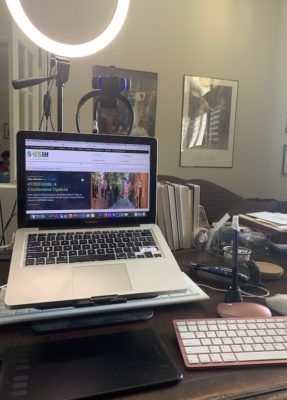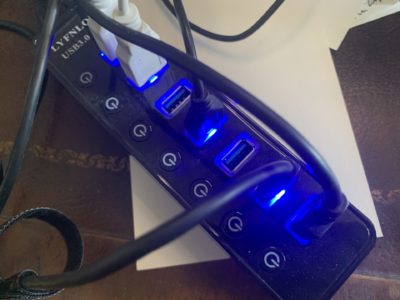What do you need in order to be able to teach from home?
Not a question I had ever considered before this spring. It has taken me quite a few months to figure out an answer, and I’m still fiddling with hardware and software. In fact, I am awaiting the arrival of a 3’ x 5’ dry-erase board on a wheeled stand, because if I am going to have to spend much more time teaching to a camera, I am going to have be able to stand and move around like I would in a classroom. We’ll see how that works once I get the thing assembled.
In the meantime, over the end of last semester and over the summer I have cobbled together an array of tools that I never in my lifetime expected I’d need to use. I am happy to share my setup here with those of you who found yourselves suddenly teaching online, and would be very interested to hear what has and hasn’t worked for you in the comments.
Now, I will say this: if I had asked for hardware from my employer, they would have tried to provide it. But I had a working laptop with a working camera, the Office 365 software suite that they provide for us, Zoom, and high-speed internet at home. While there were things I could have used to make my setup work better, there was nothing that I desperately needed.
But here’s another reason I didn’t ask my employer for any online teaching supplies: course materials we create using tools provided by our employer belong to our employer. (That’s what’s in my employee handbook, anyhow; yours may be different.) I didn’t want to pour a lot of energy into creating online instruction modules that could be repurposed or remixed for another course or another professor without my permission.
As a full-timer, I had the income to cover the expenses of paying for my own software licenses and my own digital tools. Adjuncts facing this situation would be in a different position – yet another way that capital is extracted unevenly from laborers, with those who have the least to spare becoming the most susceptible to exploitation.

My desk is a hot mess of wires, tripods, catnip crumbs, and dust.
So I bought my own stuff as I better figured out what I needed.
- A desktop tripod to hold my cell phone – about $20. The camera angle on laptops is awful unless you have them on a stand, and then stack the stand on a mountain of books. Keep your camera at or slightly above eye level!
- Using my cell phone meant transferring a video file to my hard drive to do even simple editing and uploading to YouTube, which took a lot of time. So I got a Logitech HD Pro C920 Webcam – about $75. This was backordered on Amazon but I found one at the local Best Buy and they handled delivery.
- My own Zoom account — $40 a month or thereabouts. At first I used it to record my lectures, but now I use OBS (more on that below). I needed Zoom anyhow to livestream for my church, and didn’t want to do that through a work account. So now I am a paying Zoomer.
- A 11”x14” dry erase whiteboard – I would write out terms out quickly during live discussions with my students and then hold up the whiteboard to the camera. My students thought it was funny, and it worked for me. About $20.
- Once I realized there was no escaping the ambient noise of my home – the dog, the cat, the dog and the cat fighting, the sound of people going up and down the stairs next to my office, the sound of the toilet flushing next to my office (FFS people!), etc, etc, etc – I decided I would be better off using a telemarketer style headset to record my audio. So I got a Logitech USB headset with a noise-cancelling mic – about $30.
- The lighting in my office changes a lot throughout the day, and there was a golden hour to film, but I could rarely ever find it, and it didn’t often coincide with optional live Zoom chats with my classes. So I bought a ring light which, as far as I can tell, just evenly illuminates marks of aging. Better than casting shadows, I suppose. The ring light came with its own tripod, and the tripod is pretty nice, so I was happy with that. About $50.
- A powered USB 3.0 HUB, because I have an old Mac laptop (thank heavens!) that uses USB 3.0, and all these peripherals I purchased are also powered by USB 3.0, and if I wanted to use more than two of them at a time, I needed more ports. I had a little four port extender so that I could use a USB keyboard and mouse with my ancient Mac (its internal keyboard is decrepit), but the camera needed more power from the port than the extender could provide. So, my fancy plastic USB 7-port externally powered extender: $30.
That’s everything I purchased during the semester specifically for online teaching — $225 in miscellaneous hardware and a recurring expense of $40 per month.
After the semester was over, though, I volunteered to teach a class for my church on the history of racism in America. Teaching that class gave me a good opportunity to experiment with some other tools that might enhance my teaching. One of those tools is free and wonderful for both livestreaming and recording, and I commend it to you: OBS Studio, free open-source video recording and livestreaming software.
I heard about OBS from my kids (of course) who suggested it as an easier and more flexible tool than Zoom. They were right. You can set up a variety of layouts and move seamlessly between them, you can change the size of the thumbnail video that overlays your slides, you can add captions and text and all kinds of nifty things, group them and re-use them, and so forth. I’m not a big software geek – Zotero and Scrivener and all those tools that make fairly simple tasks so damn complicated are not for me.
But OBS makes a very difficult task – presenting pedagogy “in the round” via a screen – so much easier.

So. Many. Wires.
Once I had OBS and had figured out how to design screens with multiple windows that accomplished what I needed, I bought a very simple graphics drawing tablet with a battery-free stylus so that I could open a small whiteboard window in OBS and take notes / write down terms during class discussion. The only problem there is my handwriting, which is truly abysmal. But more practice with this tool should help. The pad/stylus is made by HUION and it cost me $40.
Finally, to capture the audio while I’m standing at my rolling whiteboard ($80), I bought a Bluetooth headset with a microphone ($25).
That’s my setup, for $370 plus a year of Zoom at about $500. So almost $1,000 invested in a range of tools I would need to teach from home this fall.
Unfortunately, my school’s plan for the fall entails face-to-face instruction. But when the outbreaks start and we must once again pivot quickly to a different teaching modality, this time I’ll be ready…if the Rona doesn’t get me first.

One Thought on this Post
S-USIH Comment Policy
We ask that those who participate in the discussions generated in the Comments section do so with the same decorum as they would in any other academic setting or context. Since the USIH bloggers write under our real names, we would prefer that our commenters also identify themselves by their real name. As our primary goal is to stimulate and engage in fruitful and productive discussion, ad hominem attacks (personal or professional), unnecessary insults, and/or mean-spiritedness have no place in the USIH Blog’s Comments section. Therefore, we reserve the right to remove any comments that contain any of the above and/or are not intended to further the discussion of the topic of the post. We welcome suggestions for corrections to any of our posts. As the official blog of the Society of US Intellectual History, we hope to foster a diverse community of scholars and readers who engage with one another in discussions of US intellectual history, broadly understood.
Update: the Bluetooth headset I bought only works with my phone, not my laptop. So I picked up a wireless UHF microphone that pairs with a 3.0 USB receiver — about $50. Also, my $50 ring light died after three months of use (fabulous) so I bought two $25 ring lights, one to use at my desk and one to use when I’m standing in front of my whiteboard. One of the ring lights came with missing parts for its tripod, so I’m improvising there. Also, my cat bumps my whiteboard camera regularly while she plops down on my unread New Yorker mags, so I have to readjust it and put stoppers (usually stone coasters) against each leg so it doesn’t get toppled. Here is a pic of my setup from the “backstage” side of the desk: My Rube Goldberg Office-cum-Recording-Studio